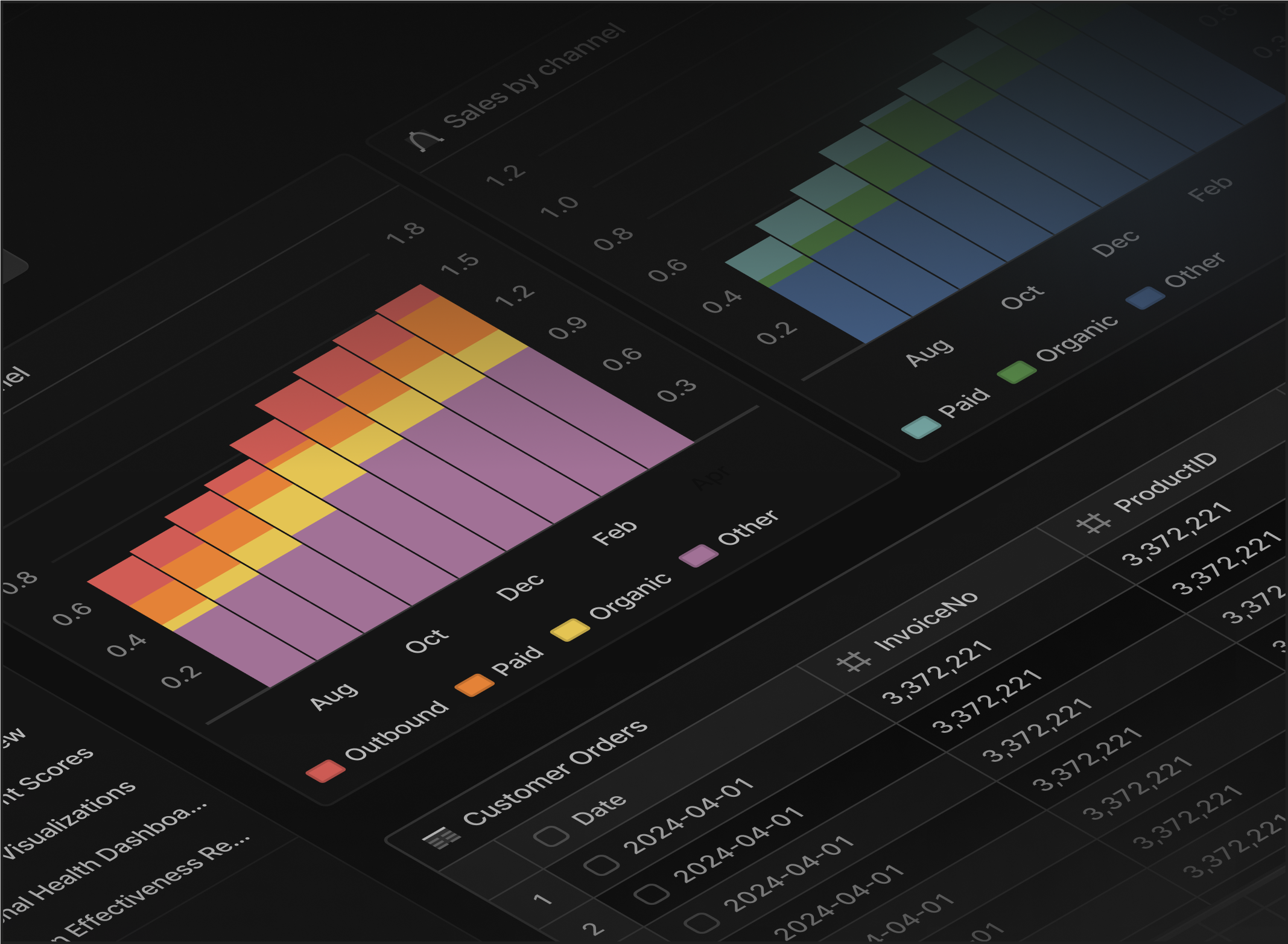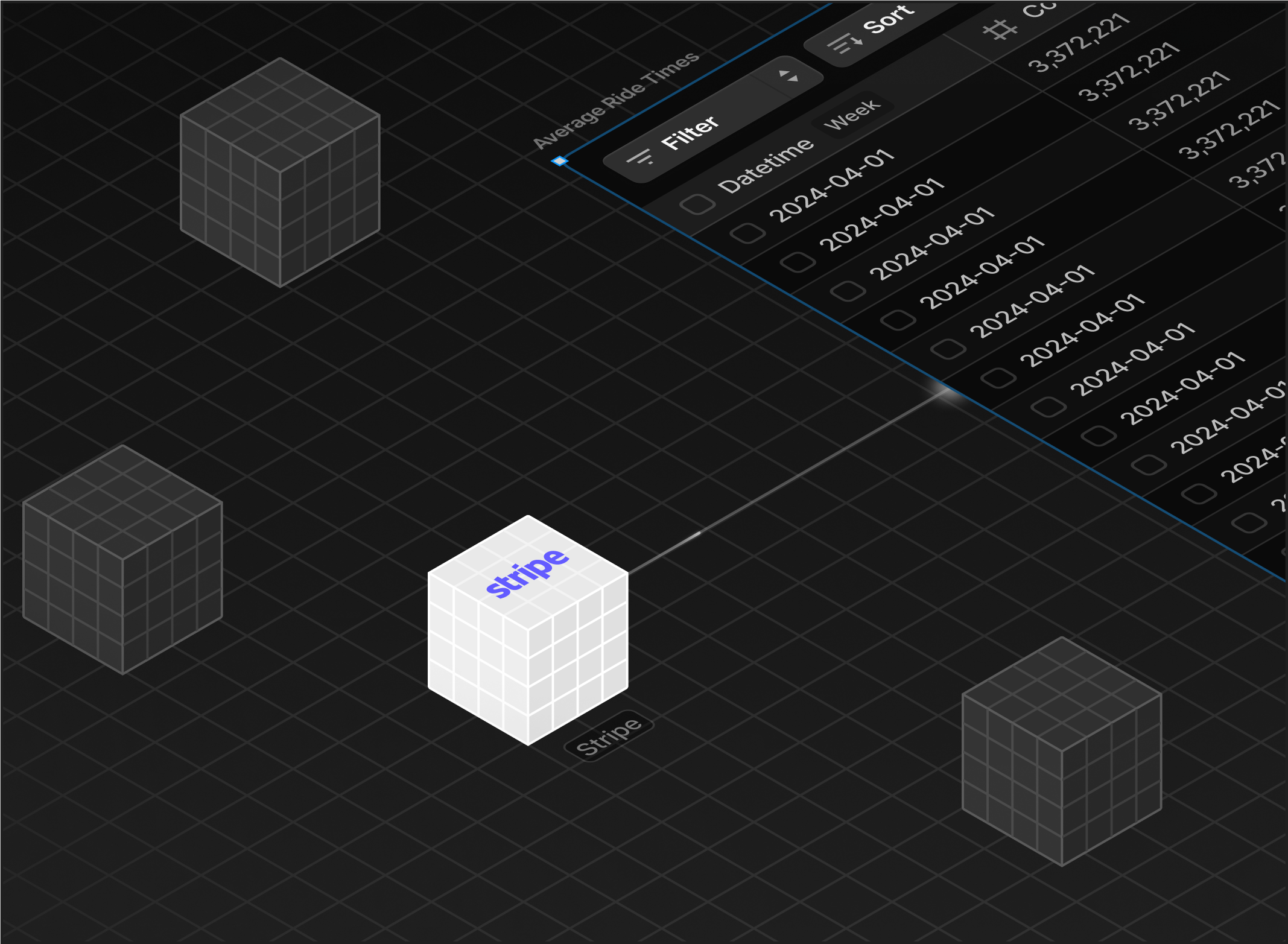Connector Database / GitHub
Analyze your GitHub data with AI
Build interactive dashboards, generate automated reports, and unlock business intelligence insights from your GitHub data with AI-powered assistant.
_

Start with a question
Generate automated reports and business intelligence insights from your GitHub data—as fast as you can ask them.


Build dashboards and data visualizations
Transform your conversation into dynamic data visualizations on an intuitive data canvas.
Integrate all your data
Unify your GitHub data with DuckDB-powered data warehouse including S3, HubSpot, MySQL and Zendesk.

Available GitHub Data
Extracts rich GitHub data across repositories, organizations, and users. It covers repository metadata, commits, issues, pull requests, comments and reviews, releases, labels, branches, tags, collaborators, contributors and stargazers, discussions, dependency graph, Actions workflows and runs, deployments, traffic analytics, and organization teams and members. This enables engineering analytics (velocity, quality, code review and CI/CD health), community and engagement tracking (stars, discussions, contributors), dependency risk insights, and organizational visibility (projects, teams, roles). Uses both REST and GraphQL APIs, plus limited HTML scraping for dependents and extra metrics.
Organization
A GitHub organization and its portfolio of repositories and members; enables org-level analytics like repo coverage, membership growth, and team structure for ownership and access insights.
Team
A team within an organization used to group people and ownership; supports attribution of work and activity by team, coverage of critical repos, and cross-team collaboration analysis.
Repository
A code project with metadata and governance; powers repository-level KPIs such as activity and health, language composition, branch/tag hygiene, and community readiness (README and community files).
Dependency
Inventory of dependencies a repository uses and dependents that rely on it; enables supply-chain risk, upgrade cadence, and adoption/impact analysis across the ecosystem.
Contributor
People and bots contributing code to a repository; supports engineering throughput, concentration of contribution, and code churn analysis over time.
Stargazer
Users who star repositories and the time they starred; used to measure community interest, growth trends, and cohort analyses of star acquisition.
Repository Traffic
Views, clones, top referrers, and popular paths for a repository; enables engagement and discovery analytics to understand audience, content performance, and traffic drivers.
Issue
Work items and bug reports (including PRs as issues) with comments and events; supports backlog health, response SLAs, triage effectiveness, and time-to-close metrics with label/assignee segmentation.
Pull Request
Code change proposals with commits, reviews, and review comments; enables lead time for changes, review efficiency, approval rates, merge velocity, and PR size/complexity analysis.
Commit
Individual code changes with authorship and diffs; used to measure delivery throughput, commit cadence, and code churn (additions/deletions) by author, team, or branch.
Release
Versioned releases and assets; supports release cadence, time between releases, and mapping of changes from tags to released artifacts.
Milestone
Time-bound goals grouping issues and PRs; enables roadmap tracking, burn-down, completion rates, and schedule risk assessment.
Workflow Run (GitHub Actions)
CI/CD workflows, runs, and jobs with step timings; powers build success rates, flakiness, failure causes, and run/step duration trends.
Deployment
Deployments and their statuses across environments; enables DORA metrics like deployment frequency, change failure rate, and MTTR via status outcomes and timestamps.
Discussion
Threaded discussions with categories, comments, replies, and reactions; supports community engagement analysis, answer rates, and sentiment on topics.
Project (Projects V2)
Project boards and items with configurable fields; used for cross-repo planning, WIP limits, cycle/lead time, and progress tracking across teams.
Authentication Required
Uses a GitHub personal access token or a GitHub App key to authenticate (short‑lived installation tokens supported with automatic rotation for rate limits)
Getting started with
GitHub Analytics & Business Intelligence
Connect your GitHub data
Connect to GitHub once and automatically sync data to your centralized data warehouse for real-time reporting and analytics.
Build business intelligence models
Create automated reports, dashboards, and data visualizations with customizable business logic and AI-powered insights for consistent analytics across your organization.
Generate reports and insights
Create interactive dashboards, automated reports, and data visualizations with AI-powered business intelligence. Share live analytics and scheduled reporting with your team.
Want to see how easy it is to get started?
GitHub usersDefinite
People love Definite because it lets you focus on what matters. Setting up your own data infrastructure doesn't make your beer taste better. Skip the tedium and start at analytics.
I was leading the efforts of setting up a business intelligence function. I was surprised how complex this all was to do even today. It's something that every tech company would need at some point but it hasn't been simplified. You need a whole team focused on building a data warehouse, setting up the right pipelines, and then integrating a BI tool on top.Definite wasn't only the answer to this problem, it tackled the next problem I knew I'd have as soon as the BI tool was ready — how do we get non-technical teams and people to learn and utilise such a tool.
Our analytics before Definite consisted of dozens of Excel sheets that took hours to update. Manual updates led to errors. Everyone questioned the accuracy of the numbers. Many people just stopped looking at the reports.After Definite, everything ran like clockwork.We immediately saved thousands of dollars per month in the time spent updating reports and have built strategies (e.g. improved ROI on ad spend, inventory management, etc.) on the data that will yield millions to our bottom line.
Have questions?
Find answers.
Definite has everything you need to deploy analytics within your company.
Data doesn't need to be so hard
Get the new standard in analytics. Sign up below or get in touch and we'll set you up in under 30 minutes.